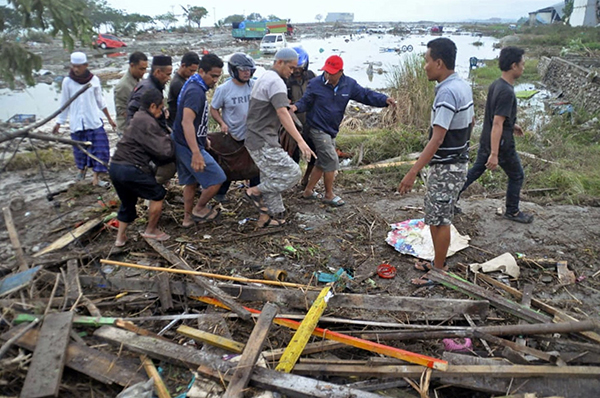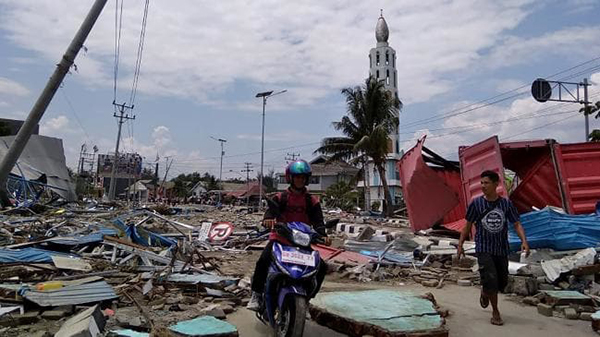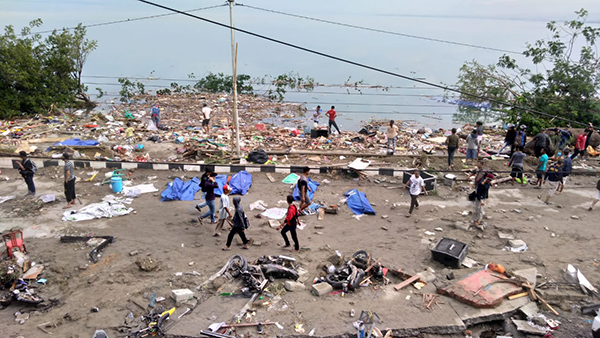Tsunami in Indonesia: The restaurant was washed away by the 3-meter wave and the cross-sea bridge was washed away.
"The situation in the affected area is chaotic, people are running in the streets, buildings collapse and ships are washed ashore." Dwikorita Karnawati, head of the Indonesian Meteorological and Geophysical Bureau, described the scene after the September 28 earthquake and tsunami.
On September 28th, an earthquake of magnitude 7.7 occurred in Central Sulawesi, Indonesia, which subsequently triggered a tsunami.
According to the statistics of Indonesian Disaster Reduction Agency on the 29th, the earthquake and tsunami have caused 384 deaths and hundreds of injuries. With the advance of rescue work, the death toll of tsunami caused by earthquake in Indonesia is rising further. The Indonesian Disaster Reduction Agency also said that many "bodies" were found on the beaches in Indonesia.
The above-mentioned institutions also said that due to the paralysis of local communications, they have not received a more comprehensive report of casualties for the time being. Nugroho, spokesman of Indonesian Disaster Relief Agency, said the impact of the disaster was "extensive", with thousands of houses washed away and some people missing.

"This is the strongest earthquake I have ever encountered, and we all ran out of the building." Yanti, a 40-year-old housewife from East Gala, said.
Mohammed Fikree, another resident from East Gala, said that he fled from his home after the earthquake, but he did not encounter large-scale panic.
"Everything in my house is shaking and cracks appear on the wall." Fikree said, "This is not the first time (earthquake). The last earthquake caused us a stronger sense of shock, so this time we didn’t panic very much. We fled the building and now everything is back to normal."
According to Singapore’s Lianhe Zaobao, the first earthquake occurred at about 2 pm local time yesterday (1 pm Beijing time), with a magnitude of 6.1, and another earthquake with a magnitude of 7.5 occurred about 4 hours later. The epicentres of the two earthquakes were located 78 kilometers north of Palu, the capital of Central Sulawesi Province. The second earthquake triggered a tsunami.
After the tsunami, Indonesia’s local TV station broadcast a video taken with a mobile phone on the 29th. In the video, when the distant waves suddenly hit the coast of Palu, people screamed and ran away in panic. The photographer of this video is located in a tall building not far from the coast. The coastal town of Palu has a population of 350,000.
Where the lens swept, the small restaurant set up along the beach was washed away by the waves, and the city streets were full of building debris wrapped in seawater, and the telephone poles were skewed. In the picture, a mosque has partially collapsed, but it is not clear whether it is due to the impact of the earthquake or tsunami.

The city of Palu, Sulawesi province was devastated by the earthquake and tsunami. According to the BBC, this video was shot about 80 kilometers from the epicenter of the earthquake.
According to previous media reports, the 3-meter-high tsunami triggered by the earthquake in Central Sulawesi province hit two cities, Palu and Donggala, and many residential areas were invaded by seawater.
Photos spread in the media and social networking sites showed that some victims’ bodies were wrapped in blue body bags, parked on the roadside where building debris remained, and survivors walked by. Some affected hospitals transferred the wounded at the first time.

The body of the victims temporarily parked on the roadside, Palu City, was built according to makassar strait, and the narrowness of the strait increased the destructive power of the tsunami impact. On the streets of the city, fragments of buildings are scattered everywhere. In the nearby city of Donggara, a sea-crossing bridge with a yellow arch was washed away by huge waves.
Initially, the Indonesian Meteorological and Geophysical Bureau declared that earthquakes would not cause tsunamis. Subsequently, Dwikorita Karnawati, the head of the agency, confirmed to Reuters that the tsunami hit the city of Palu in makassar strait, which connects Celebes and the Java Sea.
The disaster situation in nine villages is still unknown.
To make matters worse, the lack of electricity and communication has made the search and rescue work more difficult.
After a staff member of the Central Sulawesi Museum in Palu confirmed the impact of the tsunami on the museum to Jakarta Post, the media reported that the communication connection of the mobile phone "collapsed".
Mirza ali Sam, a resident from Kendari, the capital of southeast Sulawesi province, told the media that his uncle’s family of five was on vacation in Palu, and he had been unable to get in touch with them since the tsunami hit.
Nugroho, spokesman of Indonesian Disaster Relief Agency, said that the Indonesian military is deploying troops to Palu and Donggara, and the police have mobilized to help with emergency response. Search and rescue personnel and disaster relief agency personnel are working at the same time.
At present, the evacuation work is in progress, and people are warned to be vigilant and stay outside.
"People are encouraged to gather in safe places, away from hillsides." Nugroho said. "It is best not to enter houses or buildings, because there is a great possibility of aftershocks." After the magnitude 7.7 earthquake on the evening of 28th, there have been many aftershocks, including a magnitude 6.7 aftershock.
"Many houses collapsed," Akris, a staff member of the Indonesian Disaster Relief Agency, told the Associated Press that the disaster situation in nine villages is still unknown.
The main airport in Palu was also closed after the tsunami and is expected to be closed for at least 24 hours. Nugroho said that helicopters can still land at the airport if necessary, but AirNav, which is used to monitor the flight system, shows that the runway of the airport has cracked and the control tower has been damaged.
Over the past month or so, there have been many earthquakes in Indonesia, including an earthquake measuring 5.9 on the Richter scale in northern Sulawesi province of Indonesia on September 8, an earthquake measuring 5.5 on Sombawa island of Indonesia on August 26, and several earthquakes in Lombok, Indonesia during August. This series of earthquakes has caused 515 deaths and 7,145 injuries.
On the evening of 28th, Indonesian Prime Minister Joko said that he had instructed the Minister of Security to coordinate various government departments to deal with the earthquake and tsunami disaster in Central Sulawesi province.
Stephane Dujarric, a UN spokesman, said that UN officials are in contact with Indonesian authorities and are "ready to provide support as needed".
Indonesia is located in the Pacific volcanic belt, where the continental plates meet, resulting in frequent earthquakes and volcanic activities. The worst is the December 2004 earthquake, when a super strong earthquake of magnitude 9 or above occurred on the Indian Ocean seabed west of Sumatra, which triggered a tsunami and killed 226,000 people in 13 countries in Southeast Asia and South Asia. In Indonesia, 168,000 people were killed.